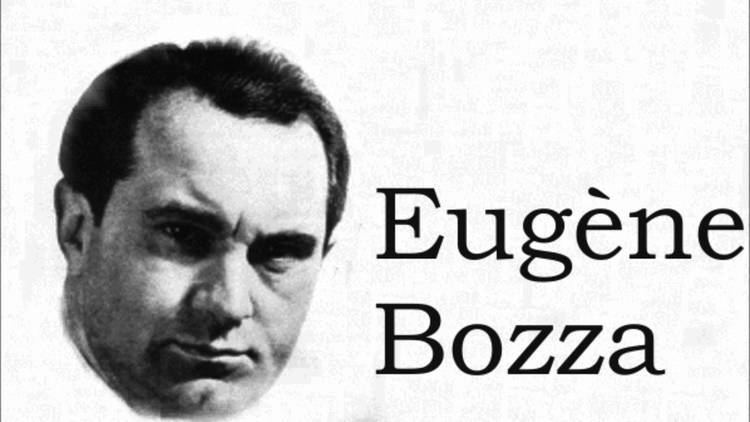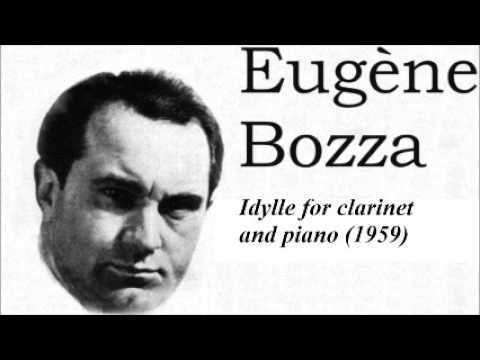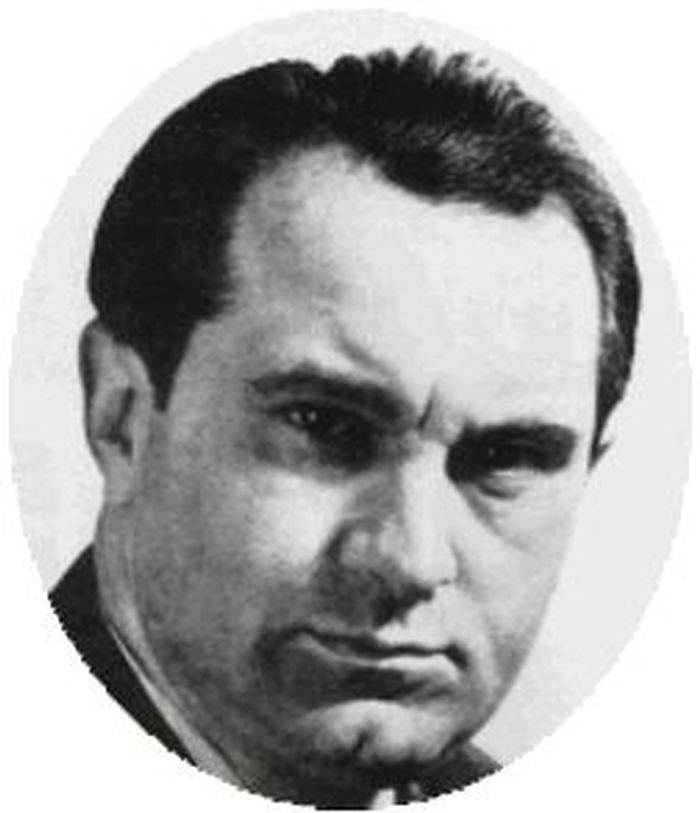Role Composer Name Eugene Bozza | Website Eugene Bozza Website Years active 1920–1991 | |
 | ||
Full Name Eugene Joseph Bozza Spouse(s) Juliette Arnaud (m. 1924-1952)Nelly Baude (m. 1954-1991) Children Pierre Bozza, Cecile Bozza Died September 28, 1991, Valenciennes, France Similar People Jean Francaix, Jacques Ibert, Henri Tomasi, Pierre Max Dubois, Marcel Mule | ||
Eug ne bozza aria organ solo premiere
Eugène Joseph Bozza (4 April 1905 in Nice – 28 September 1991 in Valenciennes) was a French contemporary composer and violinist. He remains one of the most prolific composers of chamber music for wind instruments. Bozza’s large ensemble work includes five symphonies, operas, ballets, large choral work, wind band music, concertos, and much work for large brass or woodwind ensembles. His larger works are rarely performed outside his native France.
Contents
- Eug ne bozza aria organ solo premiere
- Frigariana Eugne Bozza Jason Dovel trumpet
- Childhood and early years 1905 1915
- Formative years 1915 1934
- Middle years and career 1934 1950
- Academic career and later life 1950 1991
- Compositions
- Important works
- Reception
- Premieres Prix de Paris Conservatorie
- Other awards
- Honors
- References

Frigariana - Eugène Bozza (Jason Dovel, trumpet
Childhood and early years (1905-1915)

Bozza was born in 1905 to an Italian musician and a French woman in the coastal town of Nice, France. His father, Umberto Bozza, was a violinist who made his living playing in French casinos along the Mediterranean coast. His mother, Honoré Molina, was only a young girl from Nice when she met Umberto and conceived Eugène. With a professional musician for a father, Bozza was exposed to great music right away and took a liking to it. Eugène began studying the violin with his father when he was only 5 years old. Under such expert tutelage, Bozza flowered into an outstanding young violinist and would occasionally go with his father to performances and play with the orchestra. In 1915, at the age of 10, Bozza and his father moved to Italy to avoid the turmoil of World War I.
Formative years (1915-1934)

After moving to Italy with his Father in 1915, Bozza studied violin, piano, and solfège in Rome at the Accademia Nazionale di Santa Cecilia. He graduated in 1919 with a Professor of Violin diploma. Bozza then returned to France and enrolled in the Paris Conservatoire in 1922 where he studied violin with Edouard Nadaud. After 2 years of work he earned the Conservatorie's Premier Prix for violin and secured the chair of concert master at L'orchestre Pasdeloup in 1925. He married Juliette Arnaud, his first wife, in 1924 and had a son, Pierre, in 1925. After 5 years of touring Europe with the orchestra, Bozza resigned and returned to the Conservatoire to study conducting with Henri Rabaud. His wife once confided that, "In fact, he was haunted by stage fright." Continuing his pattern of excellence, Bozza ended his study of conducting in 1931 by winning another Premier Prix, this time for conducting. Bozza was hired as the conductor for the Ballets Russes of Monte Carlo where he stayed for only a year before returning the Paris Conservatoire for a third and final time in 1932 to study musical composition. Following another two-year study with Henri Büsser, Bozza again won the Premier Prix for his area.
Middle years and career (1934-1950)

Bozza won the Prix de Rome in 1934 for his work La Légende de Roukmani, a one-act cantata. As part of the prize, he lived in Rome at the Villa de Medici for the following four years and five months so he could focus on growing as a composer, developing a voice, and honing his art. In Rome, Bozza composed several large-scale works such as his opera Leonidas, his Psalms, and the Introduzione and Toccata for piano and orchestra. He then returned to Paris after being appointed to conduct the Opéra-Comique from 1938-1948.
Academic career and later life (1950-1991)

In 1950 he was appointed the director of the École Nationale de Musique, in Valenciennes and maintained the position until his retirement in 1975. The years spent at the École Nationale were extremely productive for Bozza. He composed many of his books of etudes and solo works during this time for students and staff at his school. Additionally, while at the École Nationale he was made a Chevalier of the Légion d’Honneur in 1956. He divorced Juliette Arnaud in the early 1950s. Also during his time at the École Nationale he met his second wife, a pianist named Nelly Baude, and had a daughter, Cécile, who went on to study at the Paris Conservatoire and become a harp professor in Denain. After retirement in 1975 Bozza stayed in Valenciennes and continued to write music. He fell ill late in life and died in 1991.
Compositions
See List of compositions by Eugène Bozza
Bozza was a prolific composer throughout his life. Beginning in the mid-1930s, Bozza published at least one new work each year until just a few years before his death in 1991. Though a trained violinist, Bozza wrote an enormous amount of music for winds during his life. Most of his wind music was composed and published during his time in Valenciennes. There are over 250 known published works as well as a wealth of manuscripts. During a posthumous assessment of the archives of Bozza's music over 70 unpublished manuscripts were found as well as several dozen that are no longer in print.

Bozza moved to Paris and studied music in the time between World War I and World War II. During this time the musical styles in Paris were moving away from romanticism and impressionism and towards the ideas of wit and eclecticism as laid out in Jean Cocteau’s 1918 manifesto Le Coq et l’Arlequin. Cocteau said, "We have had enough clouds, waves, aquaria, watersprites, and nocturnal perfumes." These ideals of music being sharp, cutting, and always new are present in nearly all of Bozza’s music. Additionally, Bozza’s works are widely known to be very sensitive to the techniques of the instrument(s) for which they are written. "Shepherds of Provence I. Pastorale Provencale" on YouTube His style shows many traditions of French Impressionist school mixed with the fundamental mastery of harmony of Bach. His compositions can be placed within the Neo-Classicist genre which is also populated by Darius Milhaud and Igor Stravinsky.
Another major influence on his compositional style was the result of the cultural infusion which occurred during and following World War I. Over two million American soldiers were sent to the European theater which included roughly 10% African American soldiers.Jazz had been developing over the previous 40 years and very little cultural connection had occurred. The influx of American and African American soldiers brought new styles and attitudes about music which were assimilated in French villages. This style of music quickly became part of French popular music and Bozza was introduced to it at an early age. Elements of jazz style and harmony are present in many of his works.
Another significant element of Bozza's output was educational methods and étude books. During his tenure as director in Valenciennes, Bozza composed at least 18 étude collections for many instruments including: violin, double bass, flute, oboe, clarinet, bassoon, saxophone, trumpet, horn, and trombone. This compositional history lends itself as a partial explanation to the popularity of Bozza's music in academic institutions.
Important works
An unaccompanied work for solo flute, Image is a substantial piece that showcases many elements of flute technique including extreme registral and timbral changes and flutter tongue. "Image for Flute" on YouTube
Concerto for Clarinet and Chamber Orchestra is a three-movement work and one of 19 concertos written by Bozza. "Clarinet Concerto, Mvt. 1" on YouTube
Bozza created a deep repertoire of music for Bassoon. Recit, Sicilienne, et Rondo is a solo piece with piano accompaniment that explores both the high and low range of the bassoon. Due to its technical demands and lyrical melodies, this piece is a mainstay of the conservatory repertoire for bassoon. "Recit, Sicilienne, et Rondo" on YouTube
Aria, a piece written for Alto Saxophone and Piano, draws inspiration from the works of J. S. Bach, especially the Manual for the Fantasy in F and the Pastorale in F Major (BWV 590). It is one of his most played works for saxophone and has been transcribed for clarinet by publisher Éditions Alphonse Leduc. The piece was written during Bozza's stay in Rome at the Villa de Medici for French saxophonist Marcel Mule. Some of the lore around this piece says that it was written very quickly after Bozza was questioned about how much he had accomplished in the first few months in Rome.
Nuages for Saxophone Quartet is indicative of the Impressionistic side of Bozza. This scherzo focuses on the image of clouds and showcases masterful technique on the saxophone. Written in 1946, this piece comes from his time as the director of the Paris Opera Comique and had the best instrumentalists available to him. "Nuages for Saxophone Quartet" on YouTube
In his horn solo, En Forêt, the impressionistic technique of planing can be seen in the piano part combined with a solo part that is masterfully written for the instrument. Bozza also reminds us of the horn's roots as hunting horns with frequent calls and responses. This piece is one of the mainstays of the solo horn repertoire as well as one of the most difficult pieces overall.
New Orleans for Bass Trombone and Piano is a solo work written in 1962 for bass saxhorn. Since that instrument has fallen to obscurity, this solo is now frequently played on bass trombone or tuba. Influenced heavily by the jazz culture of New Orleans, this piece explores many styles that might be heard walking around the city such as ragtime and dixieland. This piece is a major element of the bass trombone solo repertoire and is often called upon for auditions.
Bozza's Concerto for Tuba and Orchestra represents a significant addition to the major solo repertoire for the Tuba.
Reception
Though he spent much of his life in the central and southern large population centers of Paris and Valenciennes, many of Bozza’s stage works were premiered in Lille, located in northeastern France. His work transcended the metropolitan mentality and he felt the music would be well served in this more pastoral area. Large works such as symphonies, concertos, and operas are largely unknown outside of central Europe, but his solo and chamber works are fixtures in music schools throughout the world.
Bozza's music has largely been a critical and popular success. His style was normally highly accessible to both listeners, students, and academics and he composed such mass of solo and chamber music that his name is common in studios. Norman Heim, professor of clarinet at the University of Maryland, may have encapsulated the success of Bozza's work with this: "He is a performer's composer, in that the music is well written for the instrument, is challenging to play and enjoyable to rehearse. He is the listener's composer since the music is always interesting, and has a familiarity of melody and tonality that even the untrained ear can enjoy." A testament to the universality of his music, when Bozza died at midnight on September 28, 1991, his woodwind quintet Scherzo was being played on Belgian Radio at the request of a listener.
Bozza remains frequently played and recorded today (Naxos Music Library lists 126 albums with recordings of his works and a YouTube search for Bozza yields thousands of videos). However, whether it be from a family desire for privacy or the apathy of researchers, very little has been written about his life (especially the earlier years). Reference editions such as the Grove Music Dictionary have very short entries or sometimes no entries whatsoever. Most modern writing about his past cites a single dissertation, published in 1978, by Denise Rogers Rowen about his bassoon music.
